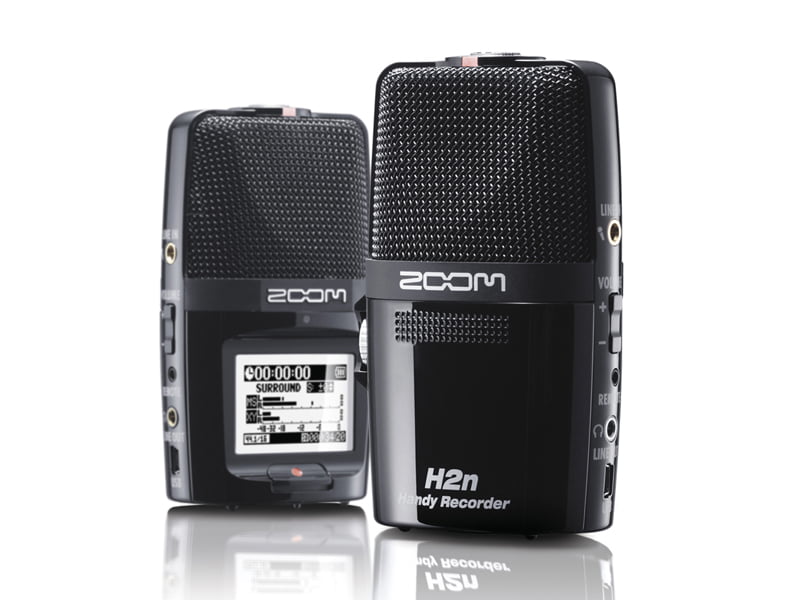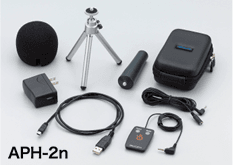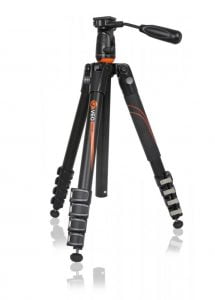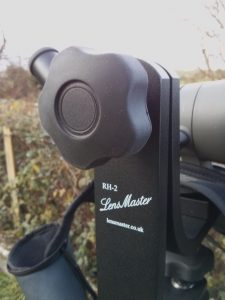
Pros: portability, impressive microphone array, outstanding battery life, manual gain dial, great sensitivity, superb sound quality and competitive price.
Cons: the device is ALL microphone, and the mics are incredibly sensitive so you have to be careful not to shift your grip while recording or you will pick up the sound of your fingers moving on the case. Battery cover is a bit stiff / tricky to open, and the rocker selection control can be a bit fiddly to operate at first, but you soon get used to it.
Price: €153 (H2N) + €24.95 (Accessory Pack)
Value: Excellent
Rating: Highly Recommended
View details of the Zoom H2N via the Irish distributor Walton’s website.

It’s also great for recording high quality field notes when viewing birds and wildlife, and the quality of the recordings mean it’s ideal as a portable recorder for things like podcasts and interviews. All in all a superb all-round digital audio recording device for the wildlife and nature enthusiast.
Buy the Zoom H2N on Amazon
Zoom H2N Handy Recorder: Full Review
Wildlife sound recording is something I’ve always fancied dabbling in. Not in any hugely expensive or technical way — just recording some of the amazing natural sounds that we so often take for granted around us.
As a young lad I remember trying all sorts of makeshift set-ups — including a parabolic microphone using a cheap plastic mic and an old umbrella, hooked up to an old cassette recorder — the results were shockingly bad… but I had lots of fun trying. So when I received the Zoom H2N Handy Recorder for review from the Japanese company’s Irish distributor, Walton’s in Dublin, I couldn’t wait to get out in the field and give it a whirl.
First Impressions
The recorder certainly looks the part.
All black, the bulk of the body is made up of the microphone arrays that sit behind a black metal mesh and black foam for protection — which is an important consideration for a field recorder. There is a dial selector on the top of the device allowing you to select different microphone configurations for different recording situations; a relatively large LCD screen and a prominent record button on the front; a menu button, rocker selector, gain control dial and on-off switch on the right hand side of the device, and a line in port, volume rocker, line out and mini-USB port on the left side. On the back there’s the battery cover which houses just 2 AA batteries. On the bottom you’ll find a slot for the included 2GB SD Card (supports up to 32GB) and a tripod thread mount.
The device is very neat and compact, and feels solid and well made, without being overly heavy even with the batteries inserted. It sits comfortably in the hand for on-the-move recording, or slips neatly into a pocket when you’re on the go.
Ease of use
I’m not going to run through all of the features of the H2N — you’ll get all that “ad-nauseam” in the product description pages of the sites that sell it. I will cover briefly how easy and straightforward it is to use. Basically it’s a doddle — switch it on, push the big button on the front with the red “record” symbol on it and you’re recording, push the button again to stop. Recordings can be time-and-date stamped or not, depending on how you have it configured.
You access the menus via the menu button, and make your choices via the rocker / selector switch just below it. This takes a little getting used to, but works very well once you do, and is surprisingly intuitive. The menu system itself is well thought out, and logical, with all of the main features easy to find and set up. The default settings are perfect for general purpose recording and make it really easy to get started “out of the box”. There’s also a handy “Factory Reset” option to take things back to their initial settings if you mess anything up — so all good.
Top marks to Zoom for designing an easy to use device that delivers great recordings right off the bat, and gives lots of scope to customise to your particular needs once you get used to it.
Recording Modes

Hidden behind the Zoom H2N’s metal mesh are five studio quality microphones that offer four different recording modes to suit any situation you find yourself in.
Mid-side (MS) recording mode
The H2N is the world’s first handheld recorder to offer a Mid-side recording feature, and it works very well, particularly for recording things like birdsong while retaining the context provided by some of the ambient background sounds.
Mid-Side recording combines a uni-directional mic that captures sound from directly in front of you, and bi-directional side mics that captures sound from left and right. By increasing altering the level of the side mics you can control how much or how little of that background sound you include in the recording. A neat trick that offers a unique degree of flexibility in a handheld recording device.
XY Stereo recording mode
The H2N also features a pair of 90° X/Y stereo condenser mics arranged with the right and left mics on the same axis. The design makes sure that both mics are equidistant from the sound source and provides accurate localization with no phase shift. In English that translates into crystal clear stereo recording with natural depth. Great for recording high quality field notes for reference later, or even for recording your next wildlife podcast interview.
2 Surround Sound recording modes
By using the Mid-Side and X/Y mics together the H2N allows you to create 360° surround sound recordings.
There are surround sound options — a 2-channel recording mode, which combines the Mid-Side and X/Y mics into a single stereo file, or a 4-channel mode, which records two separate stereo files, offering more flexibility in post-production.
Audio Quality
The quality of the recordings from the Zoom H2N is excellent as far as I can tell — although it has to be said my exposure to high quality audio equipment is pretty limited. For what I need as a wildlife and nature enthusiast occasionally recording wildlife sounds, field notes and voice interviews for later reference (and maybe publication as a wildlife podcast… if / when I finally get around to it).
There are lots of different recording formats available to offer the perfect balance between audio quality and file size — although in practice I tended to just use the highest quality lossless WAV (48KHZ 24 bit) for recording things like bat calls from a time-expansion bat detector for analysis in acoustics software, or the highest quality compressed 320kbps MP3 files for general purpose recording.
Both produce excellent recordings in a wide range of conditions.
Using the Zoom H2N in the field
Using the Zoom in the field is a piece of cake — for recording animal and bird sounds I selected MS mode, and set the gain using the analogue dial so that the meters were peaking at around -12db (as specified in the manual — there’s also an auto-gain setting but I found manually adjusting the gain gave more consistent results), and hit record.
One thing you do have to be careful of is adjusting your grip on the device while recording. The microphones are very sensitive, which is a good thing, but altering your hold on the black plastic body during recording will result in unwanted noise in your audio file. Using the screw-in mic handle that comes with the optional accessory pack helps alleviate this problem, but you do sacrifice some pocketability with it attached.
Another problem out in the field can be the inevitable wind noise — but that’s going to be an issue whatever recorder you use, and can be reduced significantly by applying the foam wind-shield that also comes with the accessory pack.
The Optional Accessories
Walton’s also sent out the optional accessory pack with the Zoom H2N. As well as the aforementioned mic handle and wind shield it also includes a hard clamshell-style case to protect the recorder, a small tabletop tripod for desk-based recording, a wired remote control and a remote extension cable.
Sample Audio recorded with the Zoom H2N
Here’s a very quick sample I recorded in the office with the Zoom H2N pondering the creation of an Ireland’s Wildlife Audio Podcast — this is recorded directly to MP3 with no post processing or any other shenanigans in software after the fact.
Here’s are a few recordings from the garden too:
A sample recorded at the desk in the office.
A bumblebee busying itself at some flowers.
A wren singing
Conclusion
The Zoom H2N is a very capable device, and I would say it’s an ideal option for wildlife enthusiasts and field ecologists looking for a good all-round digital audio recorder that offers plenty of flexibility, excellent audio quality and a host of features at what is a very affordable price given the spec.
I’ve thoroughly enjoyed using the Zoom H2N, and I’m sure the results I get with it are only going to improve with time as my understanding of audio recording grows. If you’re in the market for a digital recorder I’d certainly recommend checking out the Zoom H2N.
Buy the Zoom H2N on Amazon
Acknowledgement
I’d like to thank Zoom’s Irish distributor, Walton’s in Dublin, for submitting the Zoom H2N for review on the Ireland’s Wildlife website.
NB. Ireland’s Wildlife has no specific affiliation to any optics or gear manufacturer and all reviews on the site are completely independent and objective. Reviews are carried out by a select team of experienced birders and wildlife watchers, and all gear is tested in Ireland under field conditions.
If you are an optics or gear manufacturer or distributor, and would like to see your wildlife related products reviewed on Ireland’s Wildlife please get in touch using the contact form and we can take things from there.









